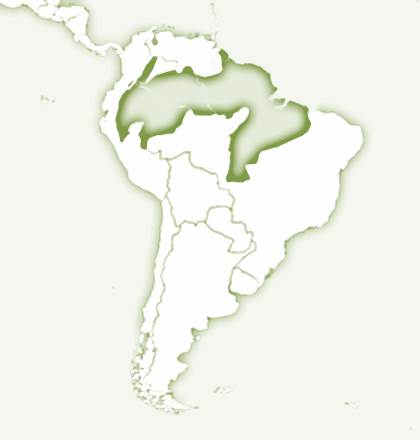Habitat & Range:  Their range overlaps with the brown capuchins’, however the squirrel monkeys’ spreads further west to include Ecuador and Columbia (Boulbi et al. 2008).They occupy upper parts of various forest types, usually foraging for food in and around the canopy, and often share habitat with the capuchins. They prefer varzea and secondary forests.
Their range overlaps with the brown capuchins’, however the squirrel monkeys’ spreads further west to include Ecuador and Columbia (Boulbi et al. 2008).They occupy upper parts of various forest types, usually foraging for food in and around the canopy, and often share habitat with the capuchins. They prefer varzea and secondary forests.
Conservation Status: Common, or South American, squirrel monkeys (Saimiri sciureus) are classed as Least Concern by the IUCN, however with the level of deforestation occurring in the Amazon basin it is unsurprising there is a slow decline in their numbers.
Feeding Behaviour :  The majority of their diet is made up of fruit
The majority of their diet is made up of fruit
but during seasons of poor fruit production they will switch their diet to
mostly animal based, eating insects and small animals such as frogs, etc. They
will forage with capuchins in order to find the best fruiting trees and increase
protection from predators with more individuals to spot a threat.
Social Structure : Large groups can be up to 100 but usually groups will have between 20 and 75 monkeys. These groups are mostly made up of females but will be a multi-male society with little in the way of a hierarchy. Males tend to be more dominant than females but there has been different social structures observed in different regions within the same species. Unlike most primates, squirrel monkeys do not groom each other to cement social bonds.
Squirrel monkeys will co-exist with the brown capuchins in the wild to gain many benefits, ranging from anti-predator techniques to food acquisition. According to Leonardi, et al. 2010, the squirrel monkeys will respond more willingly to the alarm calls of the capuchins than those of their own species, only calling to each other to maintain contact within the group.
Monkeys in Living Links: We keep capuchin and squirrel monkeys together in the same enclosure to promote natural interspecific interactions, providing enrichment for the animals and enhancing the visitor experience. The enclosure is designed to allow the two species to remove themselves from any situation where they may feel uncomfortable, i.e. the squirrel monkey part of the enclosure has a door too small for the capuchins to access, allowing the squirrel monkey to retreat if threatened (Buchanan-Smith, 2012).
References
Boubli, J.-P., Rylands, A.B., de la Torre, S. & Stevenson, P. 2008. Saimiri sciureus. In: IUCN 2012. IUCN Red List of Threatened Species. Version 2012.2. <www.iucnredlist.org>. Downloaded on 8 April 2013
Buchanan-Smith, H.M. (2012) Mixed-species exhibition of Neotropical primates: analysis of species combination success. International Zoo Yearbook, 46,150-163. PDF
Leonardi, R., Buchanan-Smith, H., Dufour, V., MacDonald, C. & Whiten, A. (2010) Living Together: Behaviour and welfare in single and mixed species groups of capuchin (Cebus apella) and squirrel monkeys (Saimiri sciureus). American Journal of Primatology 72(1):33-47.
For an overview of squirrel monkey biology, see Hannah Buchanan-Smith’s Capuchin and Squirrel Monkey Comparison
